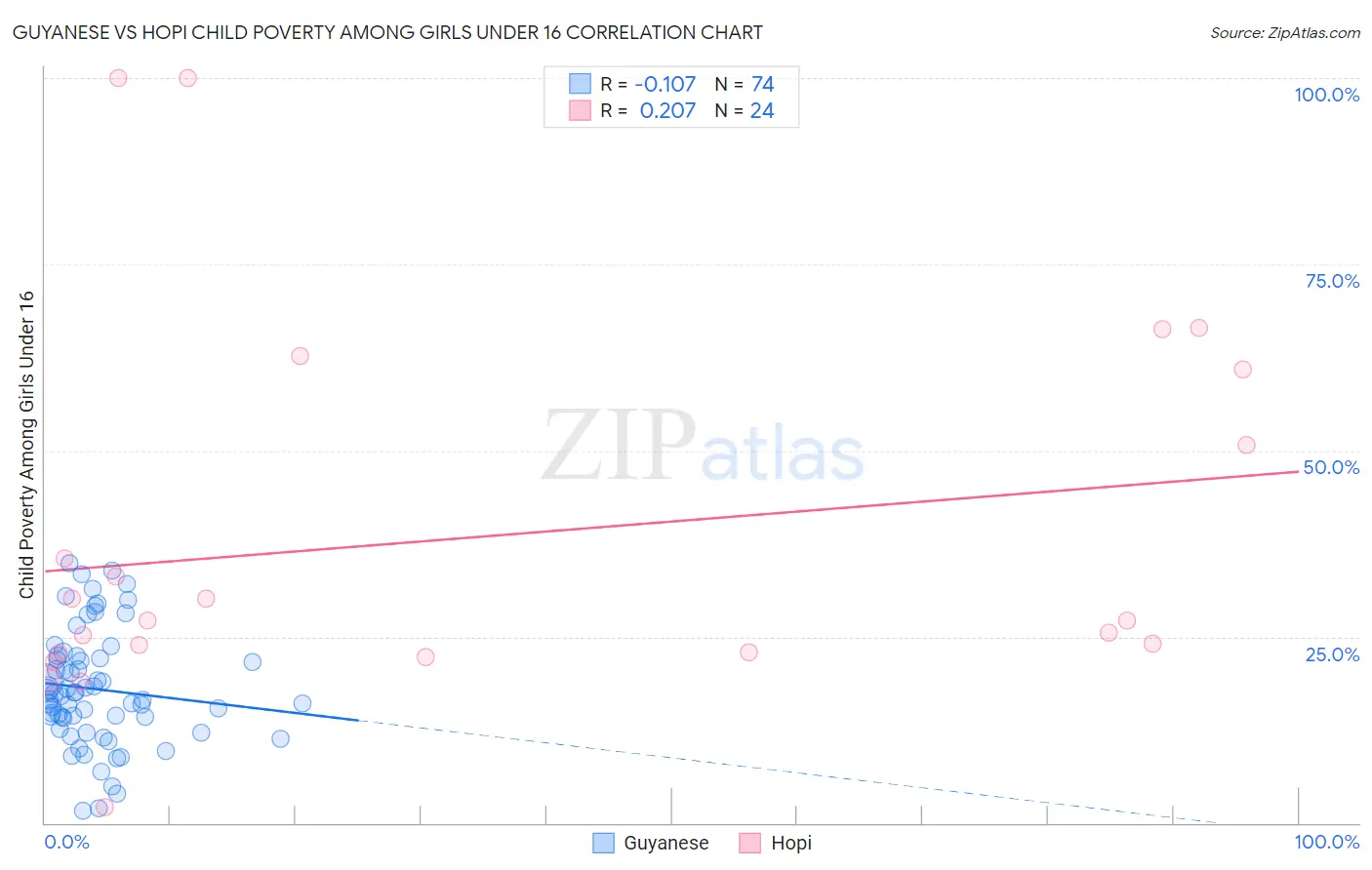Guyanese vs Hopi Child Poverty Among Girls Under 16
COMPARE
Guyanese
Hopi
Child Poverty Among Girls Under 16
Child Poverty Among Girls Under 16 Comparison
Guyanese
Hopi
19.4%
CHILD POVERTY AMONG GIRLS UNDER 16
0.2/ 100
METRIC RATING
257th/ 347
METRIC RANK
27.9%
CHILD POVERTY AMONG GIRLS UNDER 16
0.0/ 100
METRIC RATING
341st/ 347
METRIC RANK
Guyanese vs Hopi Child Poverty Among Girls Under 16 Correlation Chart
The statistical analysis conducted on geographies consisting of 175,189,173 people shows a poor negative correlation between the proportion of Guyanese and poverty level among girls under the age of 16 in the United States with a correlation coefficient (R) of -0.107 and weighted average of 19.4%. Similarly, the statistical analysis conducted on geographies consisting of 74,572,915 people shows a weak positive correlation between the proportion of Hopi and poverty level among girls under the age of 16 in the United States with a correlation coefficient (R) of 0.207 and weighted average of 27.9%, a difference of 43.9%.

Child Poverty Among Girls Under 16 Correlation Summary
| Measurement | Guyanese | Hopi |
| Minimum | 1.7% | 2.1% |
| Maximum | 34.8% | 100.0% |
| Range | 33.1% | 97.9% |
| Mean | 18.0% | 38.3% |
| Median | 17.2% | 27.2% |
| Interquartile 25% (IQ1) | 14.1% | 22.8% |
| Interquartile 75% (IQ3) | 22.1% | 55.8% |
| Interquartile Range (IQR) | 8.0% | 33.0% |
| Standard Deviation (Sample) | 7.6% | 25.3% |
| Standard Deviation (Population) | 7.5% | 24.7% |
Similar Demographics by Child Poverty Among Girls Under 16
Demographics Similar to Guyanese by Child Poverty Among Girls Under 16
In terms of child poverty among girls under 16, the demographic groups most similar to Guyanese are Salvadoran (19.4%, a difference of 0.13%), Ottawa (19.4%, a difference of 0.23%), Trinidadian and Tobagonian (19.3%, a difference of 0.25%), Immigrants from Ecuador (19.3%, a difference of 0.31%), and Immigrants from Western Africa (19.3%, a difference of 0.33%).
| Demographics | Rating | Rank | Child Poverty Among Girls Under 16 |
| Cape Verdeans | 0.3 /100 | #250 | Tragic 19.2% |
| Immigrants | Trinidad and Tobago | 0.3 /100 | #251 | Tragic 19.2% |
| Immigrants | Middle Africa | 0.3 /100 | #252 | Tragic 19.2% |
| Immigrants | Guyana | 0.3 /100 | #253 | Tragic 19.3% |
| Immigrants | Western Africa | 0.3 /100 | #254 | Tragic 19.3% |
| Immigrants | Ecuador | 0.3 /100 | #255 | Tragic 19.3% |
| Trinidadians and Tobagonians | 0.2 /100 | #256 | Tragic 19.3% |
| Guyanese | 0.2 /100 | #257 | Tragic 19.4% |
| Salvadorans | 0.2 /100 | #258 | Tragic 19.4% |
| Ottawa | 0.2 /100 | #259 | Tragic 19.4% |
| Mexican American Indians | 0.2 /100 | #260 | Tragic 19.5% |
| Vietnamese | 0.2 /100 | #261 | Tragic 19.5% |
| Chickasaw | 0.1 /100 | #262 | Tragic 19.6% |
| Immigrants | Burma/Myanmar | 0.1 /100 | #263 | Tragic 19.7% |
| Jamaicans | 0.1 /100 | #264 | Tragic 19.7% |
Demographics Similar to Hopi by Child Poverty Among Girls Under 16
In terms of child poverty among girls under 16, the demographic groups most similar to Hopi are Pima (28.2%, a difference of 1.3%), Yuman (27.1%, a difference of 2.9%), Crow (26.4%, a difference of 5.7%), Immigrants from Yemen (29.5%, a difference of 5.9%), and Cheyenne (26.3%, a difference of 6.0%).
| Demographics | Rating | Rank | Child Poverty Among Girls Under 16 |
| Blacks/African Americans | 0.0 /100 | #333 | Tragic 24.7% |
| Menominee | 0.0 /100 | #334 | Tragic 25.0% |
| Pueblo | 0.0 /100 | #335 | Tragic 25.2% |
| Sioux | 0.0 /100 | #336 | Tragic 25.6% |
| Yup'ik | 0.0 /100 | #337 | Tragic 25.8% |
| Cheyenne | 0.0 /100 | #338 | Tragic 26.3% |
| Crow | 0.0 /100 | #339 | Tragic 26.4% |
| Yuman | 0.0 /100 | #340 | Tragic 27.1% |
| Hopi | 0.0 /100 | #341 | Tragic 27.9% |
| Pima | 0.0 /100 | #342 | Tragic 28.2% |
| Immigrants | Yemen | 0.0 /100 | #343 | Tragic 29.5% |
| Navajo | 0.0 /100 | #344 | Tragic 30.5% |
| Lumbee | 0.0 /100 | #345 | Tragic 30.7% |
| Tohono O'odham | 0.0 /100 | #346 | Tragic 31.6% |
| Puerto Ricans | 0.0 /100 | #347 | Tragic 32.7% |